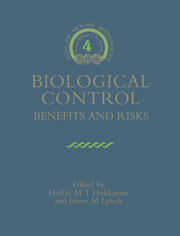Book contents
- Frontmatter
- Contents
- List of Contributors
- Series Preface
- Preface: Overview of Benefits and Risks of Biological Control Introductions
- Part I Biological Invasions
- 1 Suppressiveness of Soils to Invading Micro-organisms
- 2 Biotechnology: Environmental Impacts of Introducing Crops and Biocontrol Agents in North American Agriculture
- 3 Frequency and Consequences of Insect Invasions
- 4 Integrated Pest Management (IPM) in Fruit Orchards
- Part II Classical Biocontrol
- Part III Augmentative Biocontrol
- Part IV Use of Genetically Modified Organisms
- Part V Economics and Registration
- Index
4 - Integrated Pest Management (IPM) in Fruit Orchards
Published online by Cambridge University Press: 07 May 2010
- Frontmatter
- Contents
- List of Contributors
- Series Preface
- Preface: Overview of Benefits and Risks of Biological Control Introductions
- Part I Biological Invasions
- 1 Suppressiveness of Soils to Invading Micro-organisms
- 2 Biotechnology: Environmental Impacts of Introducing Crops and Biocontrol Agents in North American Agriculture
- 3 Frequency and Consequences of Insect Invasions
- 4 Integrated Pest Management (IPM) in Fruit Orchards
- Part II Classical Biocontrol
- Part III Augmentative Biocontrol
- Part IV Use of Genetically Modified Organisms
- Part V Economics and Registration
- Index
Summary
Introduction
The agro-ecosystems in Fennoscandia are characterized by relatively few and moderate plant protection problems. The number of pests and plant diseases is smaller than in warmer regions. Due to a shorter growing season and lower temperatures, many multivoltine insects develop only one generation a year. The beneficial fauna, primarily the many predaceous bugs (anthocorids and mirids) and mites (phytoseiids), have also proved to be highly efficient as control measures.
Pest control systems have been developed for several agricultural crops, which require minimum inputs of pesticides. The programmes for many greenhouse cultures, based on biocontrol, and those for fruit crops, using integrated approaches, have been especially successful.
Development of IPM in Norwegian fruit orchards
In the 1950s and early 1960s a spray programme that consisted of 6–8 annual applications was commonly used against insects and mites. This heavy routine spray programme was expensive and caused undesirable environmental impact.
An extensive research programme on IPM, which started in the 1960s, provided important information on the biology and ecology of major pests and their natural enemies. Based on this new knowledge, the use of pesticides could be reduced. By 1974, farmers who had adopted IPM in their orchards, used only 0–3 pesticide applications a year without significant damage to the crop (Edland, 1989a). During recent years, common use of scab-warning devices has resulted in further reduction of spray programmes. Thus, in 1988 the average use of insecticides and acaricides was 1.1 sprays and of fungicides 3.5 sprays, for the whole season in many orchards (Edland, 19896). This is less than 20% of what is being used in integrated fruit production in some other European countries (Prinoth, 1990).
- Type
- Chapter
- Information
- Biological ControlBenefits and Risks, pp. 44 - 50Publisher: Cambridge University PressPrint publication year: 1995
- 1
- Cited by



